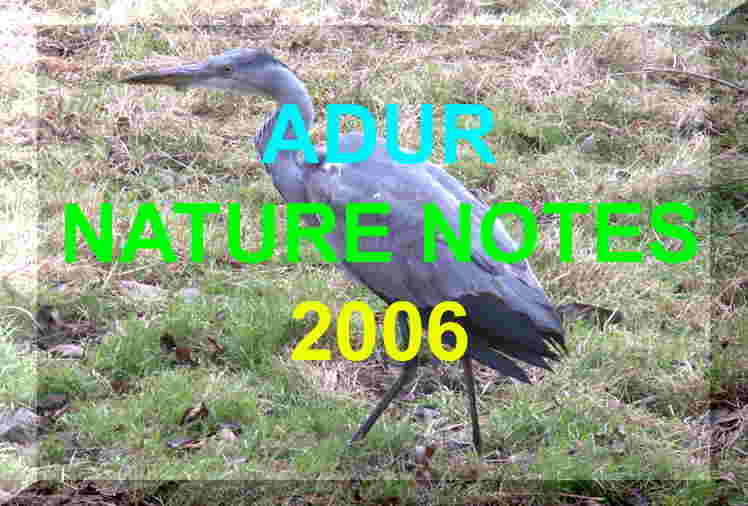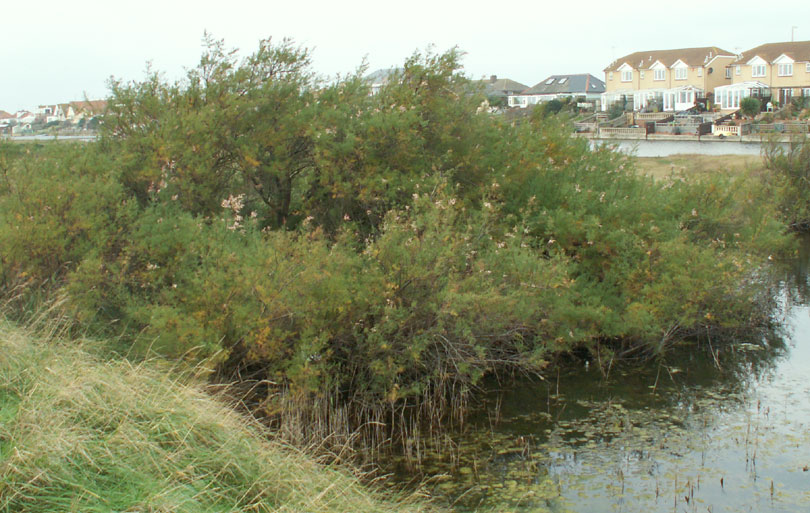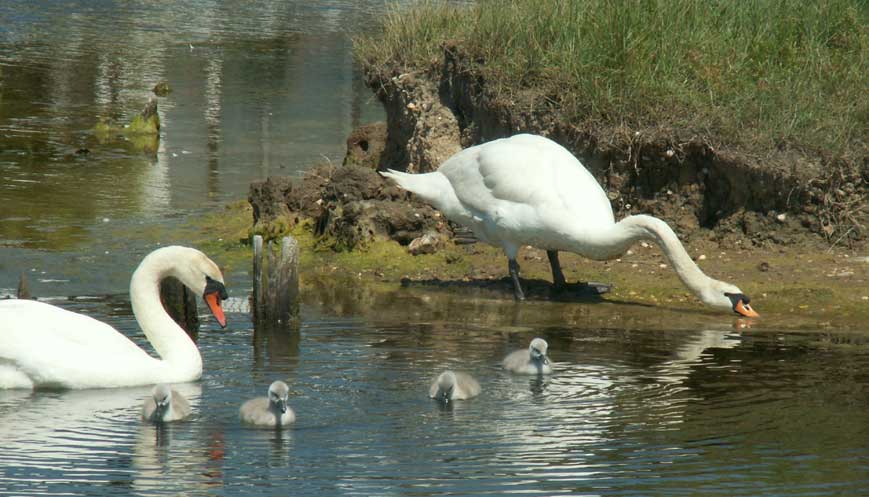Coastal
Zone
WIDEWATER
LAGOON
Brackish
Water Lagoon
|
Overview
Widewater
is a landlocked brackish lagoon approximately 1066 metres long and 90 metres
at its widest point when the lagoon is in flood. It was created by Man
from the original Adur
estuary after been landlocked by longshore
drift and violent storms. The waters are replenished by the sea, which
filters
up through the basin of the lagoon on very high tides, and also by
rain water. There is a dramatic rise in the level after heavy rainfall,
more than can be explained by the rain landing directly on the lagoon flood
plain. Man has built up banks on the perimeter of the lagoon to prevent
flooding to this nearby reclaimed land, now turned to residential use.
The quantity of water contained within the lagoon and
salinity
are liable to fluctuate wildly. The flood plain covers an area of 18.5
acres.
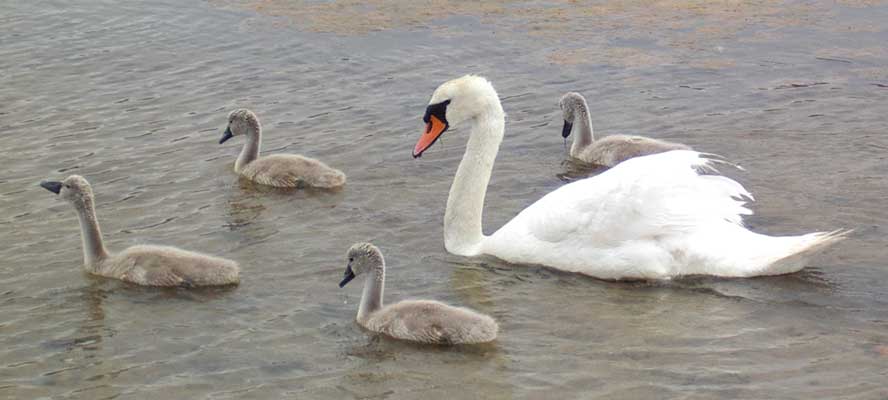
At
its maximum flooding with a measurement on the gauge by the bridge giving
a depth of 1.60 metres, the lagoon will cover an area of 4.6 hectares (=
11.4 acres) with a perimeter of 2282 metres.

|
Little Egret (left)
|
|
Photographs
by Andy Horton
Wildlife
Reports
Widewater
Reports 2007
6 December
2006
Three
Little
Grebes were seen on Widewater Lagoon.
They quickly dived under the water. There could have been more of these
small fish-eating birds.
22
November 2006
A
flash of turquoise and a Kingfisher
flew like an arrow out of the Tamarisk photographed below. Simultaneously
two Little
Grebes dived under water as the Kingfisher
flew
over them. Less than a minute later, the Kingfisher
was
seen again as a Little
Egret took off from the shallows of the
flooded lagoon. Three Mallards
dropped in, hanging in the air before they descended.
15
November 2006
The
Water
Rail was reported to have been seen when
it ventured out of its hiding place under the Tamarisk
and in shallow brackish water near a small island east of the bridge. I
could not see or hear anything of this bird that must be very good at hiding
in a small area which was inacessible because of the boggy nature of the
land and water. Was it the same bird that
visited Widewater earlier in the year (but not recorded on these Nature
Notes pages)?
Tamarisk
A
Little
Grebe was seen diving under the surface
in the deeper water. A Cormorant
was standing on a pole on the lagoon further to the west.
12
September 2006
The
flooded lagoon registered 1.64 metres on the gauge
by the bridge, as high as the lagoon gets after the spring tides of the
last few days.
The
Rock
Lavender plant was discovered on the gravel
near the pipeline. Previously, its nearest location was on the chalk cliffs
east of Brighton.
14
August 2006
One
adult Mute Swan
led a troop of eight almost fully grown grey
cygnets on Widewater Lagoon flooded by
the recent high spring tides.
8 August
2006
There
is much more water seen in the lagoon than would normally be expected after
a warm July without
any rain. This is because of the pipeline
from the sea. 3-spined
Sticklebacks were very common again in
the lagoon and they were joined by the young of the Sand
Smelt, Atherina
presbyter, which must have come as
juveniles through the pipeline. Two Little
Egrets were feeding regularly. I did not
see any of the small prawns
that were abundant last year.
6 June
2006
There
was a Mallard
on an island but absolutely no sign of a Red-breasted
Merganser
on Widewater. There did not appear
to be any cygnets
with the second group of
Mute Swans at
first, but then four fluffy cygnets
ventured
out from the shelter of a parent on a Tamarisk
island. The 3-spined
Sticklebacks were common again and could
be seen darting around underwater, and this may have attracted the interest
of the usual Little Egret.
There were probably at least two, but these birds are now so familiar I
rarely note their numbers.
On
the flood plain where the gravel and pebbles
had been disturbed to install the pipeline, there was a varied collection
of plants as though the terrain had never been disturbed in the first place.
Ivy-leaved
Toadflax still dominated but there was
plentiful Sea Kale,
Bird's
Foot Trefoil,Sea
Campion, Thrift, Sea
Beet, Cat's Ear, Stonecrops
and other plants, including a few Yellow-horned
Poppy.
| There
were also escaped and naturalised garden plants, some in abundance, but
these white plants were seen on the grass margins, next to the broken flint
wall, north of the bridge. They were Snow-in-Summer,
Cerastium
tomentosum.
Wild
Flower Images |
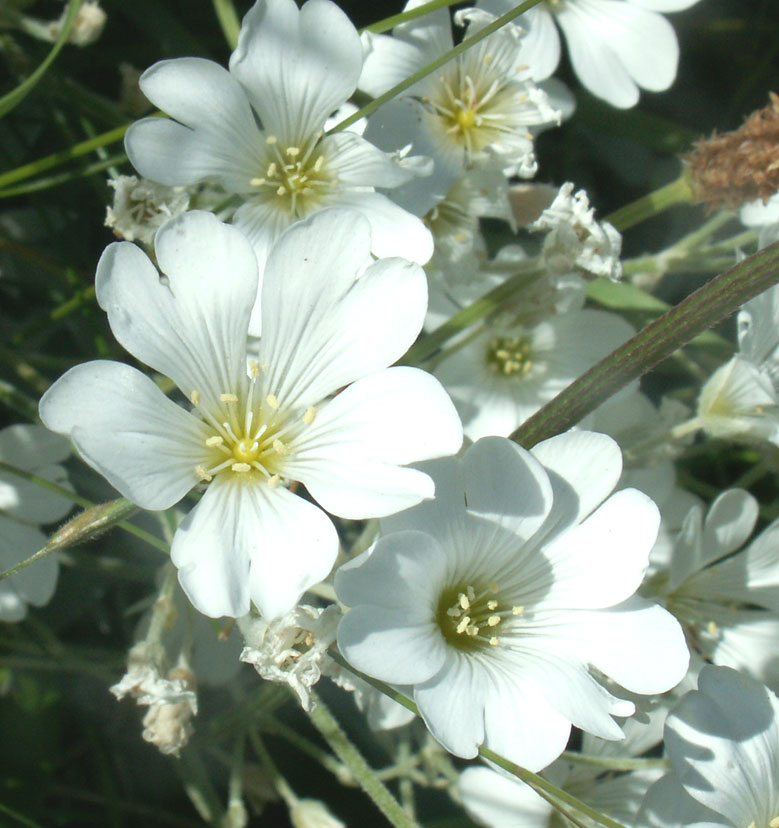 |

4 June
2006
The
Red-breasted
Merganser was still on Widewater, it did
not look oiled but preened its left flank frequently suggesting it might
be trying to clean up something.
10
May 2006
The
Mute
Swans appear to have had six
cygnets
this year. My view was a bit obscured though.
8 May
2006
In
the evening produced (to my surprise) a drake Red-breasted
Merganser was sitting on the tiny islet,
quite alone, quite close to the concourse/footpath that runs through the
lagoon. The bird seemed fairly approachable.
NB:
Mergansers
are unrecorded inshore outside the months of October
to March. They
are passage migrants offshore until May.
A
usual
Little Egret
was fishing in the shallows by the
Tamarisk
island and then the Grey Heron
spotted us passing and took a short flight.
21 March
2006
A
Red-tailed
Bumblebee,
Bombus
lapidarius, flew into some long grass at the east end of Widewater
Lagoon.
13
March 2006

I counted
half a dozen Teals feeding
upended in their characteristic way east of the bridge and just east of
the Tamarisk
island on the flooded lagoon. Later a couple of female Mallards,
with males in company, fed in the same way.
9 March
2006
A
Water Rail is seen around the Tamarisk
island on Widewater.
15
February 2006
| The
Mute
Swan cygnets have moulted and they appear
to be one moult away from their full adult plumage. I discerned that their
beaks were not yet as orange as their parents. I spotted a single Dunlin
on the muddy fringes, but the Oystercatcher
was
not seen. Two female Mallards
were there instead. A single chirm of just
three Goldfinches
was seen. |
 |
8 February
2006
The
Oystercatcher
and Redshank
were feeding in the shallows west of the bridge, but not in the same proximity
as before. Maybe, the two birds were just attracted to the habitat and
their closeness was just a coincidence before.
17
January 2006
My
first butterfly and my first large insect
of the year was seen flying in of the beach and sea over the fringes of
Widewater Lagoon at 2:00 pm.
Alas, it was so sudden and disappeared so quickly I could not be positive
of its identity. It was probably a Red
Admiral.
The
air temperature was 11.1 ºC.There was
no definite proof that this was an immigrant butterfly as it could have
been a hibernating butterfly that had flown out from under the eaves of
the nearby houses to the north, flown south and then north again against
the Light Breeze from the north-west. From previous
experience in late autumn, there was good chance it was an immigrant though.
Adur
Butterflies 2006
6
January 2006
Again,
the Oystercatcher
and Redshank
were feeding together in the shallows west of the bridge over Widewater.
This seems to be an opportunist arrangement.
5 January
2006
An
Oystercatcher
was actively feeding in the shallows to the west of the bridge over Widewater
dipping its beak into the black mud and occasionally I could see movement
in the gullet of the bird indicating it was swallowing a small item. The
black mud on retrieval almost obscured the red beak.

All the
time it was followed around by a Redshank
in water deep enough so the red legs of the latter wader were totally submerged.
This seemed to be a sustained feeding arrangment that lasted for the whole
15 minutes I was there and for probably much longer. The Redshank
was not seen to eat anything.
East
of the bridge, two Mute Swans
were squabbling in their usual way with wings raised one swan making a
showy attempt to attack the other one. Afterwards the swans gyrated in
circles next to each other for a few minutes. At least two Little
Egrets were feeding in the shallows of
the flooded lagoon.
Widewater
Wildlife Reports 2005
Magic
Map Link for Widewater Lagoon
World
of Widewater
(Community
Group)
| Chairman |
|
|
|
|
| Secretary |
Jo
Procter |
Tel:
01903
752505 |
190a
Brighton Road
Lancing
BN15
8LL |
EMail:
joproctor@hotmail.com |
| Treasurer |
|
|
|
|
Link
to Widewater Reports 2005
Adur
Nature Notes 2006: Index Page
|
